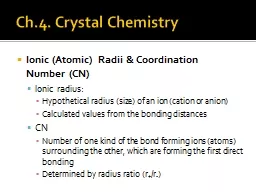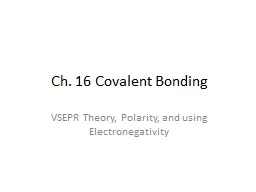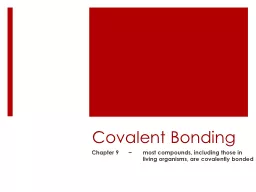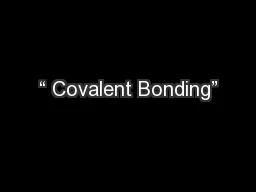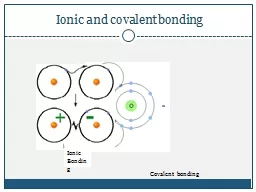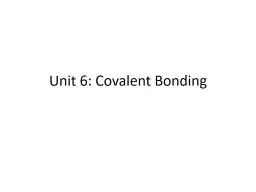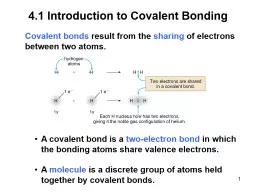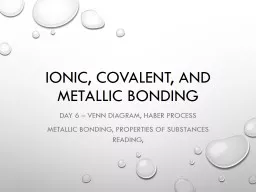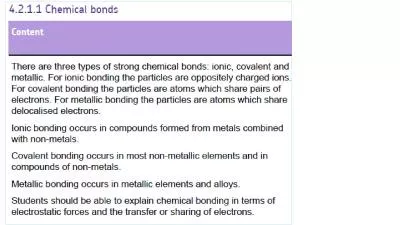PPT-Covalent bonding and Sterio
Author : reese | Published Date : 2023-07-17
hemistry VSEPR Theory According to the valence shell electron pair repulsion theory VSEPR theory the geometry of a covalent compound depends upon the number and
Presentation Embed Code
Download Presentation
Download Presentation The PPT/PDF document "Covalent bonding and Sterio" is the property of its rightful owner. Permission is granted to download and print the materials on this website for personal, non-commercial use only, and to display it on your personal computer provided you do not modify the materials and that you retain all copyright notices contained in the materials. By downloading content from our website, you accept the terms of this agreement.
Covalent bonding and Sterio: Transcript
hemistry VSEPR Theory According to the valence shell electron pair repulsion theory VSEPR theory the geometry of a covalent compound depends upon the number and arrangement in the space of electron pairs present in the valence shell of the central atom This number is half of the summation of electrons present in the valence shell of the central atom and the electrons contributed by the combining atoms Thus in the case of H. Molecular Geometry. Ch. 6 Sections 1-4 Review. In general, what determines whether atoms will form chemical bonds?. Atoms will form a chemical bond if their potential energy is lowered in doing so.. Describe the difference between ionic and covalent bonding.. Introduction to Chemical Bonding. Introduction to Chemical Bonding. Objectives:. Define . chemical bond.. Explain why most atoms form chemical bonds.. Describe ionic and covalent bonding.. Explain why most chemical bonding is neither purely covalent nor purely ionic.. . Ionic (Atomic) Radii & Coordination Number (CN). Ionic radius: . Hypothetical radius (size) of an ion (. cation. or anion). Calculated values from the bonding distances. CN. Number of one kind of the bond forming ions (atoms) surrounding the other, which are forming the first direct bonding. VSEPR Theory, Polarity, and using . Electronegativity. Covalent . Bonds. Forms when 2 atoms share a pair of valence e. -. A. Types of Covalent Bonds. 1. . Single Covalent Bond . – two atoms share . Chapter 9 ~ most compounds, including those in living organisms, are covalently bonded. What You’ll Learn. I will analyze the nature of a covalent bond. I will name covalently bonded groups of atoms. . and Structure. IB Chemistry. Topic 4. . Bond - A force that holds . atoms . together and . makes . them . function as a . unit.. 4.1 Ionic Bonding. An . ion. is a charged particle. Ions form from atoms or from groups of atoms by . Ball-and-stick model. Molecular . Compounds. OBJECTIVES:. Distinguish. between the melting points and boiling points of . molecular. compounds and . ionic. compounds.. Molecular . Compounds. OBJECTIVES:. Higher Supported Study - Week 2 . Key Areas – Periodic Trends . The trends in . covalent radius . across periods and down groups.. The trends in . ionisation energies . across periods and down groups. . Covalent bonding. Ionic bonding. Ionic Bonding. Bonding as you’ve never imagined it. http://www.youtube.com/watch?v=BCYrNU-7SfA. Objectives. To consider the features of ionic and covalent bonds, and the compounds they make. Covalent Bonding. A . chemical bond . is the force that holds two atoms together and makes them function as a unit. Atoms form bonds to become most stable and obtain an octet. Covalent Bonding: Electrons are shared between two or more elements. Always between 2 non-metals. Covalent bonds . result from the . sharing . of electrons. between two atoms.. A covalent bond is a . two-electron bond . in which the bonding atoms share valence electrons.. A . molecule . is a discrete group of atoms held together by covalent bonds.. Day . 6. – Venn Diagram, . haber. Process. Metallic . Bonding, Properties of Substances reading, . Warm up. ON PAGE 23. What do ionic and covalent bonding have in common? What is different?. Time: . Do . Now: Identify . Bond Type from Formula. Au. Ag. CO. 2. Li. 3. N. Na. 2. S. Mg. CsF. H. 2. O. NaCl. SO. 2. Cu. CH. 4. Covalent. Covalent. Covalent. Covalent. Ionic. Ionic. Ionic. Ionic. Metallic. Ionic bonds form a . giant lattice structure. Sodium chloride is an ionic compound formed by the reaction between the metal sodium and the non-metal chlorine.. During the reaction, one electron is transferred from each sodium atom to each chlorine atom..
Download Document
Here is the link to download the presentation.
"Covalent bonding and Sterio"The content belongs to its owner. You may download and print it for personal use, without modification, and keep all copyright notices. By downloading, you agree to these terms.
Related Documents



